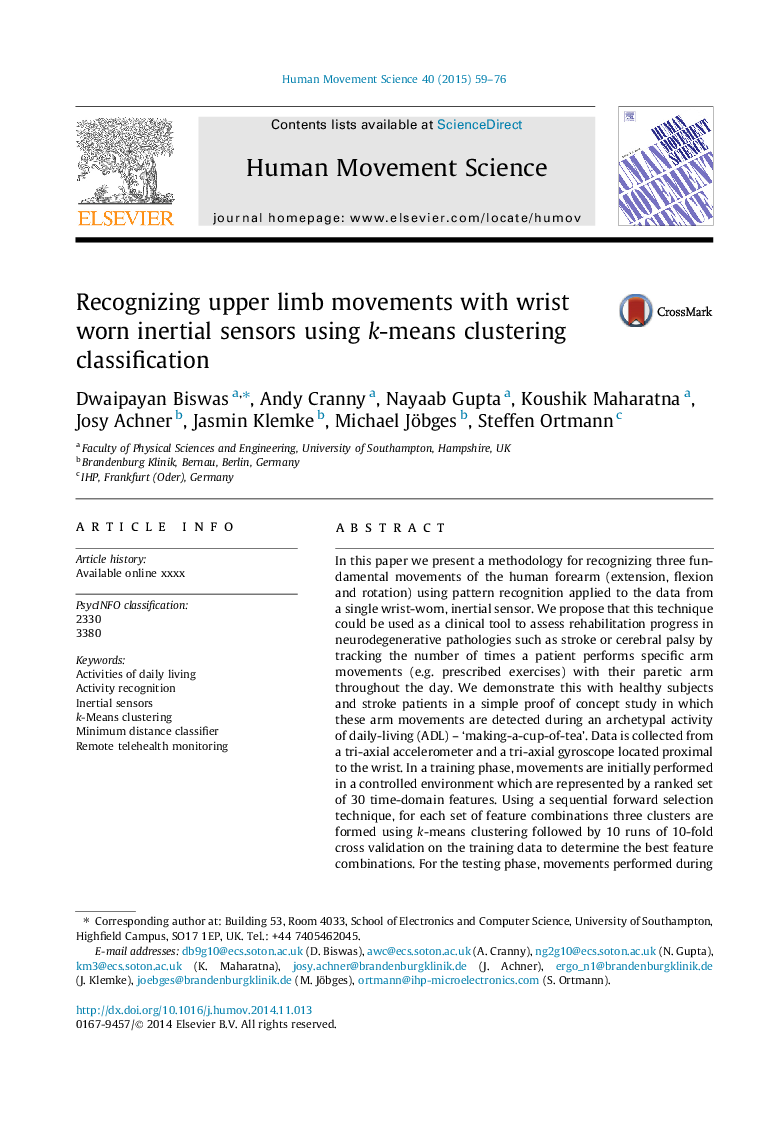| کد مقاله | کد نشریه | سال انتشار | مقاله انگلیسی | نسخه تمام متن |
|---|---|---|---|---|
| 7291997 | 1474225 | 2015 | 18 صفحه PDF | دانلود رایگان |
عنوان انگلیسی مقاله ISI
Recognizing upper limb movements with wrist worn inertial sensors using k-means clustering classification
دانلود مقاله + سفارش ترجمه
دانلود مقاله ISI انگلیسی
رایگان برای ایرانیان
کلمات کلیدی
موضوعات مرتبط
علوم زیستی و بیوفناوری
علم عصب شناسی
علوم اعصاب شناختی
پیش نمایش صفحه اول مقاله

چکیده انگلیسی
In this paper we present a methodology for recognizing three fundamental movements of the human forearm (extension, flexion and rotation) using pattern recognition applied to the data from a single wrist-worn, inertial sensor. We propose that this technique could be used as a clinical tool to assess rehabilitation progress in neurodegenerative pathologies such as stroke or cerebral palsy by tracking the number of times a patient performs specific arm movements (e.g. prescribed exercises) with their paretic arm throughout the day. We demonstrate this with healthy subjects and stroke patients in a simple proof of concept study in which these arm movements are detected during an archetypal activity of daily-living (ADL) - 'making-a-cup-of-tea'. Data is collected from a tri-axial accelerometer and a tri-axial gyroscope located proximal to the wrist. In a training phase, movements are initially performed in a controlled environment which are represented by a ranked set of 30 time-domain features. Using a sequential forward selection technique, for each set of feature combinations three clusters are formed using k-means clustering followed by 10 runs of 10-fold cross validation on the training data to determine the best feature combinations. For the testing phase, movements performed during the ADL are associated with each cluster label using a minimum distance classifier in a multi-dimensional feature space, comprised of the best ranked features, using Euclidean or Mahalanobis distance as the metric. Experiments were performed with four healthy subjects and four stroke survivors and our results show that the proposed methodology can detect the three movements performed during the ADL with an overall average accuracy of 88% using the accelerometer data and 83% using the gyroscope data across all healthy subjects and arm movement types. The average accuracy across all stroke survivors was 70% using accelerometer data and 66% using gyroscope data. We also use a Linear Discriminant Analysis (LDA) classifier and a Support Vector Machine (SVM) classifier in association with the same set of features to detect the three arm movements and compare the results to demonstrate the effectiveness of our proposed methodology.
ناشر
Database: Elsevier - ScienceDirect (ساینس دایرکت)
Journal: Human Movement Science - Volume 40, April 2015, Pages 59-76
Journal: Human Movement Science - Volume 40, April 2015, Pages 59-76
نویسندگان
Dwaipayan Biswas, Andy Cranny, Nayaab Gupta, Koushik Maharatna, Josy Achner, Jasmin Klemke, Michael Jöbges, Steffen Ortmann,